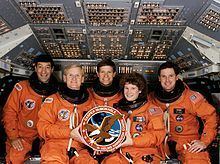COSPAR ID 1993-003A Orbits completed 96 Apogee 309,000 m Landing date 19 January 1993 | SATCAT no. 22313 Period 1.5 hours Launch date 13 January 1993 Dates 13 Jan 1993 – 19 Jan 1993 | |
 | ||
Mission type Satellite deploymentTechnology Mission duration 5 days, 23 hours, 38 minutes, 19 seconds Distance travelled 4,000,000 kilometers (2,500,000 mi) Members | ||
STS-54 was a Space Transportation System (NASA Space Shuttle) mission using orbiter Endeavour. This was the third flight for Endeavour and was launched on 13 January 1993.
Contents
Spacewalks
Mission highlights
The primary payload was the fifth Tracking and Data Relay Satellite (TDRS-F) which was deployed on day one of the mission. It was later successfully transferred to its proper orbit by the Inertial Upper Stage booster.
Also carried into orbit in the payload bay was a Hitchhiker experiment called the Diffuse X-ray Spectrometer (DXS). This instrument collected data on X-ray radiation from diffuse sources in deep space.
Other middeck payloads to test the effects of microgravity included the Commercial General Bioprocessing Apparatus (CGPA) for-life sciences research; the Chromosome and Plant Cell Division in Space Experiment (CHROMEX) to-study plant growth; the Physiological and Anatomical Rodent Experiment (PARE) to examine the skeletal system and the adaptation of bone to space flight; the Space Acceleration Measurement Equipment (SAMS) to measure and record the microgravity acceleration environment of middeck experiments; and the Solid Surface Combustion Experiment (SSCE) to measure the rate of flame spread and temperature of burning filter paper.
Also, on day five, mission specialists Mario Runco and Gregory J. Harbaugh spent nearly 5 hours in the open cargo bay performing a series of space-walking tasks designed to increase NASA's knowledge of working in space. They tested their abilities to move about freely in the cargo bay, climb into foot restraints without using their hands and simulated carrying large objects in the microgravity environment.
